Home > Attractions >
Lama Temple
Located in the northeast corner of downtown Beijing,also called Yonghe Palace.It is the mansion built by Kangxi Emperor of Qing Dynasty and gave to his forth son Prince Yong,which is known as Prince Yong’s mansion.Because Emperor Qianlong was born here, the Lama temple out of two emperors, became "Dragon dive Blessing"place.Qianlong Nine years (1744), Yonghe Palace changed to Lama Temple, the Prime Minister of Premier Affairs to manage the affairs of the palace, no reservation. It can be said that the Yonghegong temple was the highest national specification of the Qing Dynasty in the middle and late period of a Buddhist monastery.The Lama Temple mainly consists of three exquisite arches and five magnificent halls,covers an area of 66400 square meters with thousands of temples.
Architectures
The Yonghe Palace is composed of five grand halls, such as the Tianwang Temple, the main Yonghe Palace, the Yongyou Palace, the Falun Palace and the Wanfu Pavilion, as well as the west and east supporting Hall and the "Four Studies Hall" (Sermon Hall, Tantric Hall, Mathematics Hall, Pharmacist's Hall). The entire building layout shrinks gradually from south to north, while the temple rises in turn.The front of the seven buildings: Zhaotai Gate, Bell Tower, Drum Tower, Yonghe Gate, Yonghe Palace, Sermon Hal, Tantric temple, showing the Chinese Buddhist monastery "seven Galen" standard layout.The rear halls rise step by step, symbolizing the solemn auspiciousness of the Buddha's world.
Yonghe Museum
The Museum of Tibetan Buddhist Art of the Yonghegong Temple insists on serving social and social development and using existing resources to serve the public. The museum exhibition is divided into two parts, one is the temple and Buddha statues of the Yonghegong temple, basically retain the historical appearance.The second is to select the fine products of the collection and attend occasional special exhibitions.The cultural relics of the Yonghegong temple mainly include the ancient buildings, inscriptions and other non-moving cultural relics and Buddha statues, tangka, Fakun weapon and other movable cultural relics. Because the temple of Yonghegong in the Qing Dynasty has the nature of Imperial Jia Miao, the collection of Yonghegong temple is mainly derived from the Qing court gifts, Mongolian into Beijing tribute and the Qing Palace office casting Buddha statues, weapon and so on. Intangible cultural Heritage mainly includes festival law, King Kong Exorcism Dance, Buddhist music, Laba porridge, altar City production skills, noodle production skills, Tibetan fonts and so on.
Visiting Information
1.The Lama Temple is open all year round.
Winter: Nov.1st ---Mar.31st 9:00-16:00
Summer:Apr.1st ---Oct.31st 9:00-16:30
2.Tickets Price:25 RMB (Half Price:12 RMB)
- Free for handicapped visitors (valid ID required).
- Free for children no older than 6 (valid ID required) or no taller than 1.2 meters.
- Half price for youth aged 6 to 18, and for elementary, middle school, and undergraduate students (excluding graduates and adult or other continuing education students), student ID or other valid ID required.
- Half price for seniors aged above 60 (Elder ID or other valid ID required).
3.Suggested Visiting Hours:2~3hours
4.Excursions related matters:
- Salute Buddha, Dharma, monk, three incense is appropriate;
- Do not burn incense, photography in the temple;
- When the wind is large, stop burning incense please incense;
- Do not smoke in the temple; Take care of monastery artifacts and maintain environmental hygiene.
Ps:Buddhist Festival Day, different Buddhist activities will be carried out in the temple.
Further details please check on: http://www.yonghegong.cn/
Architectures
The Yonghe Palace is composed of five grand halls, such as the Tianwang Temple, the main Yonghe Palace, the Yongyou Palace, the Falun Palace and the Wanfu Pavilion, as well as the west and east supporting Hall and the "Four Studies Hall" (Sermon Hall, Tantric Hall, Mathematics Hall, Pharmacist's Hall). The entire building layout shrinks gradually from south to north, while the temple rises in turn.The front of the seven buildings: Zhaotai Gate, Bell Tower, Drum Tower, Yonghe Gate, Yonghe Palace, Sermon Hal, Tantric temple, showing the Chinese Buddhist monastery "seven Galen" standard layout.The rear halls rise step by step, symbolizing the solemn auspiciousness of the Buddha's world.
Yonghe Museum
The Museum of Tibetan Buddhist Art of the Yonghegong Temple insists on serving social and social development and using existing resources to serve the public. The museum exhibition is divided into two parts, one is the temple and Buddha statues of the Yonghegong temple, basically retain the historical appearance.The second is to select the fine products of the collection and attend occasional special exhibitions.The cultural relics of the Yonghegong temple mainly include the ancient buildings, inscriptions and other non-moving cultural relics and Buddha statues, tangka, Fakun weapon and other movable cultural relics. Because the temple of Yonghegong in the Qing Dynasty has the nature of Imperial Jia Miao, the collection of Yonghegong temple is mainly derived from the Qing court gifts, Mongolian into Beijing tribute and the Qing Palace office casting Buddha statues, weapon and so on. Intangible cultural Heritage mainly includes festival law, King Kong Exorcism Dance, Buddhist music, Laba porridge, altar City production skills, noodle production skills, Tibetan fonts and so on.
Visiting Information
1.The Lama Temple is open all year round.
Winter: Nov.1st ---Mar.31st 9:00-16:00
Summer:Apr.1st ---Oct.31st 9:00-16:30
2.Tickets Price:25 RMB (Half Price:12 RMB)
- Free for handicapped visitors (valid ID required).
- Free for children no older than 6 (valid ID required) or no taller than 1.2 meters.
- Half price for youth aged 6 to 18, and for elementary, middle school, and undergraduate students (excluding graduates and adult or other continuing education students), student ID or other valid ID required.
- Half price for seniors aged above 60 (Elder ID or other valid ID required).
3.Suggested Visiting Hours:2~3hours
4.Excursions related matters:
- Salute Buddha, Dharma, monk, three incense is appropriate;
- Do not burn incense, photography in the temple;
- When the wind is large, stop burning incense please incense;
- Do not smoke in the temple; Take care of monastery artifacts and maintain environmental hygiene.
Ps:Buddhist Festival Day, different Buddhist activities will be carried out in the temple.
Further details please check on: http://www.yonghegong.cn/






